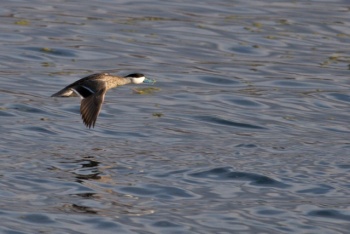m (photo info) |
(Imp sizes. Attempt to disguise copied text. Some extra info. References updated) |
||
| (4 intermediate revisions by 4 users not shown) | |||
| Line 1: | Line 1: | ||
| − | [[Image: | + | [[Image:PunaTealSJ.jpg|thumb|550px|right|Photo by {{user|Stanley+Jones|Stanley Jones}}<br />Junín, [[Peru]], August 2017]] |
| − | ;[[:Category: | + | ;[[:Category:Spatula|Spatula]] puna |
| − | |||
==Identification== | ==Identification== | ||
| − | + | [[Image:Puna Teal in Flight.jpg|thumb|350px|right|Photo by {{user|GordonH|GordonH}}<br />Puno, [[Peru]], June 2007]] | |
| + | 48–51 cm (19-20 in) | ||
| + | *Black upper head | ||
| + | *White face throat and neck | ||
| + | *Pale brown back, chest and anterior flanks with dark brown spots becoming bars on the rear flanks | ||
| + | *Grey upper tail-[[Topography#General Anatomy|coverts]] | ||
| + | *Light blue, relatively large bill, with a black line along the top of the upper [[Dictionary_M-O#M|mandible]]<br /> | ||
| + | Female is similar to male but smaller and browner. | ||
| + | ====Flight==== | ||
| + | In flight has a buff bordered, green speculum bordered in buff. | ||
====Similar Species==== | ====Similar Species==== | ||
| − | [[Silver Teal]] differs in having inner part of bill yellow | + | [[Silver Teal]] differs in having inner part of bill yellow, buff sides of head, and being overall smaller, but will not usually overlap in range |
==Distribution== | ==Distribution== | ||
| − | + | [[South America]]: found in central [[Peru]] and western [[Bolivia]] south to northern [[Chile]] and extreme north-west [[Argentina]]. | |
==Taxonomy== | ==Taxonomy== | ||
| − | + | This is a [[Dictionary_M-S#M|monotypic]] species<sup>[[#References|[1]]]</sup>. It was previously regarded as a subspecies of the [[Silver Teal]].<br /> | |
| − | + | Formerly placed in the genus ''[[:Category:Anas|Anas]]''. | |
==Habitat== | ==Habitat== | ||
| − | + | They have a preferences for slightly alkaline wetlands with a lot of floating vegetation. Observed at heights around 4,083 m. | |
==Behaviour== | ==Behaviour== | ||
| − | + | ====Diet==== | |
| + | Their diet consists of seeds and the vegetative parts of aquatic plants, grasses and sedges. They also eat aquatic invertebrates, such as insects, larvae, molluscs, crustaceans. | ||
| + | ====Breeding==== | ||
| + | The male is partly [[Dictionary_P-S#P|polygamous]]. They construct the nest in islets, hidden in long grass. Usually 4 eggs are laid. | ||
| + | ==References== | ||
| + | #{{Ref-Clements6thAug17}}# Alvaro Jaramillo. 2003. Birds of Chile. Princeton Field Guides. ISBN 0-691-11740-3 | ||
| + | #BF member observations | ||
| + | {{ref}} | ||
==External Links== | ==External Links== | ||
| − | {{GSearch| | + | {{GSearch|Spatula_puna}} |
| − | [[Category:Birds]] [[Category: | + | [[Category:Birds]] [[Category:Spatula]] |
Latest revision as of 00:58, 21 December 2017
- Spatula puna
Identification
48–51 cm (19-20 in)
- Black upper head
- White face throat and neck
- Pale brown back, chest and anterior flanks with dark brown spots becoming bars on the rear flanks
- Grey upper tail-coverts
- Light blue, relatively large bill, with a black line along the top of the upper mandible
Female is similar to male but smaller and browner.
Flight
In flight has a buff bordered, green speculum bordered in buff.
Similar Species
Silver Teal differs in having inner part of bill yellow, buff sides of head, and being overall smaller, but will not usually overlap in range
Distribution
South America: found in central Peru and western Bolivia south to northern Chile and extreme north-west Argentina.
Taxonomy
This is a monotypic species[1]. It was previously regarded as a subspecies of the Silver Teal.
Formerly placed in the genus Anas.
Habitat
They have a preferences for slightly alkaline wetlands with a lot of floating vegetation. Observed at heights around 4,083 m.
Behaviour
Diet
Their diet consists of seeds and the vegetative parts of aquatic plants, grasses and sedges. They also eat aquatic invertebrates, such as insects, larvae, molluscs, crustaceans.
Breeding
The male is partly polygamous. They construct the nest in islets, hidden in long grass. Usually 4 eggs are laid.
References
- Clements, J. F., T. S. Schulenberg, M. J. Iliff, D. Roberson, T. A. Fredericks, B. L. Sullivan, and C. L. Wood. 2017. The eBird/Clements checklist of birds of the world: v2017, with updates to August 2017. Downloaded from http://www.birds.cornell.edu/clementschecklist/download/
- Alvaro Jaramillo. 2003. Birds of Chile. Princeton Field Guides. ISBN 0-691-11740-3
- BF member observations
Recommended Citation
- BirdForum Opus contributors. (2025) Puna Teal. In: BirdForum, the forum for wild birds and birding. Retrieved 11 May 2025 from https://www.birdforum.net/opus/Puna_Teal





